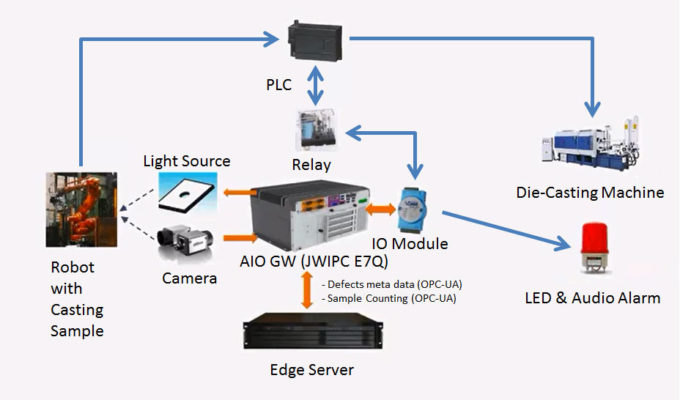A Fast Track to Machine Vision Apps

With manufacturers dedicating as much as 65 percent of their global factory budget to IIoT initiatives, business leaders are asking how they can maximize the return on their investments. For instance, will the operational benefits compensate for the cost of developing a computer vision-equipped solution from scratch? Are there more cost-effective techniques that can achieve the same goal?
A machine vision development kit can make it more affordable for manufacturers and systems integrators to embrace machine vision and artificial intelligence (AI). How? By giving them a jump-start on building a proof of concept (PoC) or a fully developed solution tailored to fit a specific factory use case.
Deployments using such kits can, for example, help manufacturers significantly reduce production-line waste, while enabling them to produce more products that meet spec and within tight time frames. Companies like JWIPC have invested in building this type of development tool, which is being deployed in a variety of manufacturing sites.
By using an automated defect detection system, Yu-Mei die-casting factory was able to increase the accuracy of its quality control processes by 20 percent.
AI Ready for Quality Control
The Yu-Mei die-casting factory is using an automated defect detection solution built from the JWIPC AI Ready Vision Kit for Smart Manufacturing. It has enabled the company to increase the accuracy of its quality control processes by 20 percent when compared with manual inspection. Defects the manufacturer can now spot include excess aluminum left on parts or within molds as well as cracks and warping in cast pieces (Figure 1).

To achieve these results, Yu-Mei’s development partner started with the hardware and software supplied in the kit. This included data ingestion and analytics software as well as Intel® Industrial Edge Insights and the Intel® OpenVINO™ Toolkit. The combination helped the development team speed up the creation of algorithms specifically designed to solve the die-casting factory’s defect-detection needs.
“With so many different industrial application scenarios and requirements, manufacturers require a lot of data and time to train algorithms,” said Disco Liu, IOT Business Unit GM for JWIPC. “Our kit provides the basic functions, which can help make it much easier to develop and deploy machine vision solutions in less time.”
Through containerization, the smart manufacturing kit can integrate vision software applications for different types of factories and use cases. This reduces the complexity of completing data storage, data analysis, and interfacing with public cloud or manufacturing execution systems.
The JWIPC offering provides a full stack that includes an industrial gateway and optional cameras and sensors to develop a working PoC or production-ready solution right out of the box. And with many machine vision applications running on the Ubuntu operating system, the OS is integrated into the kit.
This enables systems integrators to use Docker to port their applications, which helps further accelerate the development cycle. Docker is also compatible with other operating systems, reducing the need for additional coding. These and other features, as shown in Figure 2, have been incorporated into the kit.

Optimize Systems
Improving computer vision solution performance—while reducing costs—requires integrating multiple functions. These include video capture and processing, industrial communication and control, data analysis, data storage, and cloud upload. If such processes are executed on multiple devices, the solution will incur increased costs and delays, resulting in a loss of real-time performance. To avoid these issues, JWIPC enables running multiple workloads on high-performance Intel® Xeon® or Intel® Core™ processors. These options can lower costs, ensure real-time performance, and reduce maintenance workload.
The demand for industrial machine vision solutions is expected to increase in pace throughout the manufacturing sector. Yet many engineers and systems integrators lack the necessary time and expertise to develop a PoC, let alone a full-scale, end-to-end solution. This may mean missed opportunities to participate in the IIoT market expansion.
But barriers to entry can be overcome as companies like JWIPC develop machine vision platforms that simplify the development process of solutions like automated defect detection. By reducing the time and effort needed to bring machine learning to the factory floor, systems integrators can make these types of projects easier, more predictable, and profitable.